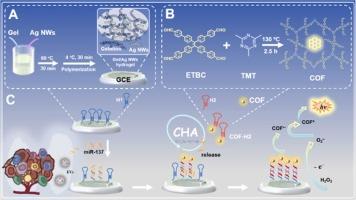新型供受体结构共价有机框架ECL水凝胶传感器用于细胞外囊泡MiRNA-137检测
IF 3.7
1区 化学
Q1 CHEMISTRY, ANALYTICAL
引用次数: 0
摘要
本研究开发了一种新型的电化学发光(ECL)生物传感器,用于检测甲状腺癌细胞外囊泡(ev)中的miRNA-137,该传感器集成了供体-受体结构的共价有机框架(ETBC-TMT COF)和导电凝胶/银纳米线(Ag NWs)水凝胶。采用乙烯链Knoevenagel缩合,采用溶剂热法合成了ETBC-TMT COF。由于窄带隙和共轭结构,ETBC-TMT COF具有较高的电子转移效率和较强的发光特性,在H₂O₂共反应物活化下表现出强劲的阳极ECL发射。此外,凝胶/Ag - NWs水凝胶具有双功能界面。一方面,水凝胶为快速电子转移提供了高离子电导率。另一方面,凝胶/Ag NWs水凝胶中存在丰富的生物相容性基团来连接生物分子。最后,采用催化发夹组合(CHA)策略对ECL信号进行放大。因此,该生物传感器对miRNA-137的检测限为0.24 fM,线性范围为1 fM - 10 nM。临床验证表明,miRNA-137在甲状腺癌ev中的表达水平可以有效地用于区分肿瘤和旁癌。本工作建立了基于ETBC-TMT cof的水凝胶生物传感器作为一种快速、高灵敏度的癌症诊断工具。本文章由计算机程序翻译,如有差异,请以英文原文为准。

Novel donor-acceptor-structured covalent organic framework-based ECL hydrogel sensor for extracellular vesicle MiRNA-137 detection
This study developed a novel electrochemiluminescence (ECL) biosensor to detect miRNA-137 in thyroid cancer extracellular vesicles (EVs), which integrated the donor-acceptor-structured covalent organic framework (ETBC-TMT COF) and conductive gel/silver nanowire (Ag NWs) hydrogel. The ETBC-TMT COF was synthesized via solvothermal method with the vinylene-linked Knoevenagel condensation. The ETBC-TMT COF exhibited enhanced electron transfer efficiency and strong luminescence feature due to the narrow bandgap and conjugated structure, which displayed robust anodic ECL emission with H₂O₂ co-reactant activation. Moreover, the gel/Ag NWs hydrogel served as a dual-functional interface. On the one hand, the hydrogel offered high ionic conductivity for rapid electron transfer. On the other hand, there was abundant biocompatible groups in gel/Ag NWs hydrogel to link biomolecules. Finally, catalytic hairpin assembly (CHA) strategy was employed to amplify the ECL signal. As a result, the biosensor achieved a low detection limit of 0.24 fM for miRNA-137 with a linear range of 1 fM–10 nM. The clinical validation revealed that miRNA-137 expression levels in thyroid cancer EVs can be used to differentiate tumor and paracancer effectively. This work established the ETBC-TMT COF-based hydrogel biosensor can be utilized for cancer diagnostics as a rapid and highly sensitive tool.
求助全文
通过发布文献求助,成功后即可免费获取论文全文。
去求助
来源期刊

Sensors and Actuators B: Chemical
工程技术-电化学
CiteScore
14.60
自引率
11.90%
发文量
1776
审稿时长
3.2 months
期刊介绍:
Sensors & Actuators, B: Chemical is an international journal focused on the research and development of chemical transducers. It covers chemical sensors and biosensors, chemical actuators, and analytical microsystems. The journal is interdisciplinary, aiming to publish original works showcasing substantial advancements beyond the current state of the art in these fields, with practical applicability to solving meaningful analytical problems. Review articles are accepted by invitation from an Editor of the journal.
 求助内容:
求助内容: 应助结果提醒方式:
应助结果提醒方式:


